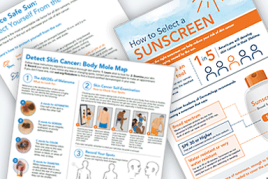8 dermatologists’ tips for preventing warts
Wearing flip-flops can help prevent warts
Wearing flip-flops or other shoes in moist areas, such as piers, pool decks, and public showers can reduce your risk of developing warts on your feet.

8 precautions that can help prevent warts
It can be difficult to prevent warts completely. The virus that causes warts, human papillomavirus (HPV), is found everywhere. However, by taking some precautions, you can reduce the likelihood of you and your family getting warts.
For fewer warts, make sure everyone in your home follows these dermatologist-recommended precautions:
Avoid touching someone’s wart and wash your hands after treating a wart. HPV is contagious. It’s possible for the virus to get inside your body through a cut or scratch, which can cause a wart.
Clean and cover cuts and scrapes. HPV is everywhere. Covering cuts and scrapes can reduce your chance of HPV getting in and causing a wart.
Make sure that everyone in your home has their own towels, washcloths, razors, nail clippers, socks, and other personal items. If someone in your home has a wart, this helps prevent the virus that causes warts from spreading from one person to another.
Wash your hands often. Because HPV is so common, this helps to remove the virus from your skin.
Prevent dry, cracked skin. When skin is cracked and dry, it’s easier for HPV to slip in through a crack in your skin, which could cause a wart.
Stop nail biting and cuticle chewing. When you bite your nails or cuticles, it causes tears in the skin, including some that are too tiny to see. These openings make it easier for HPV to get inside your body.
Wear flip-flops or pool shoes in locker rooms, pool areas, and public showers. HPV thrives in warm, moist areas. When your skin is moist and soft, it’s easier to get infected with HPV.
Treat hyperhidrosis. This is a medical condition that causes people to sweat excessively. When people sweat frequently, their skin becomes damp and soft. Having damp, soft skin may increase the risk of getting HPV infection, which could lead to a wart.
If you develop a wart
The virus that causes warts is found everywhere, so it may not always be possible to prevent a wart. If you or a family member develops a wart, you may be able to treat it yourself. At-home treatments can effectively treat one or a few small warts.
If the wart doesn’t go away with at-home treatment, the wart appears on your face or genital area, or a wart itches or bleeds, see a board-certified dermatologist. Warts can have a serious impact on your health and well-being. No one understands warts better than your board-certified dermatologist.
To find a board-certified dermatologist, go to Find a Dermatologist.
Images
References
Kirnbauer R, Lenz P, et al. “Human papillomavirus.” In: Bolognia JL, et al. Dermatology. (second edition). Mosby Elsevier, Spain, 2008:1183.
Kunin, A. “Warts.” In: The DERMAdoctor Skinstruction Manual. Simon & Schuster. United States, 2005:292-7.
Tasti A, Piraccini BM. “Nail disorders.” In: Bolognia JL, et al. Dermatology. (second edition). Mosby Elsevier, Spain, 2008:1030.
Walling HW. “Primary hyperhidrosis increases the risk of cutaneous infection: A case-control study of 387 patients.“ J Am Acad Dermatol. 2009;61(2):242-6.
Written by:
Paula Ludmann, MS
Reviewed by:
Laurel Geraghty, MD, FAAD
Carrie L. Kovarik, MD, FAAD
William Warren Kwan, MD, FAAD
Morgan Murphrey, MD, FAAD
Sanna Ronkainen, MD, FAAD
Last updated: 5/8/2025
 Atopic dermatitis: More FDA-approved treatments
Atopic dermatitis: More FDA-approved treatments
 Biosimilars: 14 FAQs
Biosimilars: 14 FAQs
 How to trim your nails
How to trim your nails
 Relieve uncontrollably itchy skin
Relieve uncontrollably itchy skin
 Fade dark spots
Fade dark spots
 Untreatable razor bumps or acne?
Untreatable razor bumps or acne?
 Tattoo removal
Tattoo removal
 Scar treatment
Scar treatment
 Free materials to help raise skin cancer awareness
Free materials to help raise skin cancer awareness
 Dermatologist-approved lesson plans, activities you can use
Dermatologist-approved lesson plans, activities you can use
 Find a Dermatologist
Find a Dermatologist
 What is a dermatologist?
What is a dermatologist?